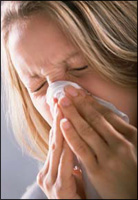 Influenza, commonly known as the flu, is one of the most persistent and debilitating diseases.
Influenza, commonly known as the flu, is one of the most persistent and debilitating diseases.
It mainly occurs in various forms as a yearly epidemic, causing severe illness among the populace. Influenza is caused by myoviruses classified as type A, B, and C. Type A influenza is the most common, causing serious and widespread epidemics.
The virus enters enters the cell through its genetic material. The virus multiplies and is released from the cell by a budding process, to be spread throughout the body.
Symptoms and signs:
The athlete with the flu will display the following symptoms:
- fever
- cough
- headache
- malaise
- inflamed respiratory mucous membranes with coryza (profuse nasal discharge).
It should be noted that certain viruses can increase the body’s core temperature. Flu normally has an incubation period of 48 hours and comes on suddenly, accompanied by chills and a fever of 102° to 103° F (39° to 39.5° C), which develops over a 24-hour period. The athlete complains of a headache and general aches and pains – mainly in the back and legs. The headache becomes more severe, along with photophobia (unusually high intolerance to light) and an aching pain at the base of the skull. There is often the symptoms of a sore throat, burning in the chest, and at the onset a light irritating cough, which may later develop into bronchitis. The skin appears flushed, and the eyes are inflamed and watery.
The acute stage of the disease usually lasts up to 5 days. Weakness, sweating and fatigue may continue for many days. The prevention of flu includes avoiding infected persons and keeping your resistance high through a healthy lifestyle. Vaccines, including prevalent strains, may be given to those at risk such as pregnant women or people in frail health.
Control and treatment:
If the flu is uncomplicated, control consists of bed rest. During the acute stage, the temperature often returns to normal. For those individuals under the age of 18 the symptomatic care such as aspirin should be avoided because of Reye´s syndrome. Amantadine vaccine is given for influenza A for those at risk. It is also beneficial for fever and respiratory symptoms. Steam inhalation, cough medicines, and gargles may be given.
Listed below are 8 Upper Respiratory Infections
![]() sinusitis
sinusitis
![]() pharyngitis
pharyngitis
![]() influenza
influenza
![]() hay fever
hay fever
![]() infectious mononucleosis
infectious mononucleosis
![]() acute bronchitis
acute bronchitis
![]() bronchial asthma
bronchial asthma
![]() exercise induced bronchial obstruction (asthma)
exercise induced bronchial obstruction (asthma)

























